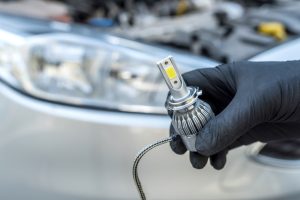Car lighting is essential for both safety and visibility. Headlights, taillights, indicators, and interior lights all play crucial roles in keeping you and others safe on the road. However, like all automotive systems, lighting components can malfunction over time due to wear, weather exposure, or electrical faults.
In this guide, we’ll walk you through the most common car lighting problems, how to identify them, and how to fix them yourself — with minimal tools and basic knowledge.
Why Lighting Problems Occur

Lighting issues can stem from a variety of causes. Here are the most common:
-
Burned-out bulbs
-
Blown fuses
-
Corroded sockets or connectors
-
Faulty switches
-
Damaged wiring
-
Malfunctioning relays or control modules
Understanding the root cause will save you time and prevent costly repairs.
Common Lighting Problems and DIY Fixes
1. Headlight Not Working
If one headlight is out, it’s likely a burned-out bulb. If both are out, consider checking fuses, relays, or switches.
Diagnostic Steps:
| Check | How to Test | Fix |
|---|---|---|
| Bulb | Swap with a known good bulb | Replace if burned out |
| Fuse | Use multimeter or visual inspection | Replace blown fuse |
| Headlight Switch | Test if high/low beam positions respond | Replace switch if unresponsive |
| Wiring/Socket | Look for corrosion or damaged connectors | Clean or replace socket/wiring |
2. Flickering Headlights
This can indicate a failing alternator, loose wiring, or ground connection issues.
Possible Causes:
-
Loose or dirty battery terminals
-
Dimming under acceleration (bad alternator)
-
Loose bulb or corroded socket
Fix Tip: Clean all grounding points and check the alternator output with a multimeter (should read 13.8–14.5V while engine is running).
3. Tail Lights or Brake Lights Not Working
When both taillights or brake lights fail, it may indicate a fuse, switch, or wiring issue.
Troubleshooting Checklist:
-
Step 1: Press the brake pedal — does the third (center) brake light work?
-
Step 2: Check the brake light switch near the pedal
-
Step 3: Inspect the fuse labeled “STOP” or “TAIL”
4. Turn Signal Doesn’t Flash or Stays On
This usually points to a failed flasher relay or a bad turn signal bulb.
Symptoms and Solutions:
| Symptom | Probable Cause | DIY Fix |
|---|---|---|
| Signal clicks fast | One bulb is burned out | Replace the faulty bulb |
| Signal stays solid | Flasher relay fault | Replace relay under dash/hood |
| Signal doesn’t work at all | Switch or fuse issue | Test and replace switch/fuse |
5. Interior or Dashboard Lights Not Working
These lights often run on a separate fuse and may be affected by the dimmer switch.
Fixes:
-
Turn dimmer knob to adjust brightness
-
Check interior fuse labeled “DOME” or “ILLUM”
-
Replace faulty bulbs (e.g., behind instrument panel)
Tools You’ll Need
Here’s a quick list of tools that can help with car lighting diagnostics:
-
Multimeter (voltage and continuity testing)
-
12V test light
-
Screwdrivers (Phillips/flathead)
-
Socket set
-
Contact cleaner
-
Dielectric grease (for bulb sockets)
Lighting Diagnostic Table
| Problem | Most Likely Causes | Solution |
|---|---|---|
| One headlight out | Burned-out bulb, socket corrosion | Replace bulb, clean socket |
| Both headlights out | Blown fuse, faulty switch, relay issue | Replace fuse/switch |
| Brake lights not working | Brake light switch failure, fuse blown | Replace switch, inspect fuse |
| Indicators flash too fast | Burned-out bulb | Replace faulty turn signal bulb |
| Interior lights not working | Blown fuse, faulty dimmer switch | Replace fuse, adjust or replace dimmer |
| Headlights flickering | Loose ground, alternator issue | Tighten grounds, test alternator |
Preventive Maintenance Tips
To avoid lighting issues before they happen:
-
Inspect bulbs every 6 months
-
Apply dielectric grease to sockets during bulb replacement
-
Clean connectors and check for rust or corrosion
-
Avoid touching halogen bulbs with bare hands (oil shortens lifespan)
-
Check battery and alternator regularly
When to Seek Professional Help

DIY troubleshooting works for most basic issues, but if you notice the following, consider seeing a mechanic:
-
Repeated fuse blowing
-
Multiple lighting circuits failing
-
Water intrusion inside light housings
-
Dash lighting or ECU errors related to lights
Upgrade Your Lighting the Smart Way
If you’re replacing or upgrading your car’s lighting, be sure to use parts that are compliant with local regulations and suited to your vehicle model.
Buy Car Lighting online to access a wide selection of OEM and aftermarket lighting solutions — everything from halogen to LED kits and accessories.
Final Thoughts
Car lighting issues may seem daunting at first, but with a methodical approach and a few basic tools, many problems can be diagnosed and fixed at home. Regular inspection and preventive care can save you time, money, and stress — especially when driving at night or in poor weather.
By staying informed and hands-on, you’ll not only enhance your car’s reliability but also your own safety and confidence on the road.